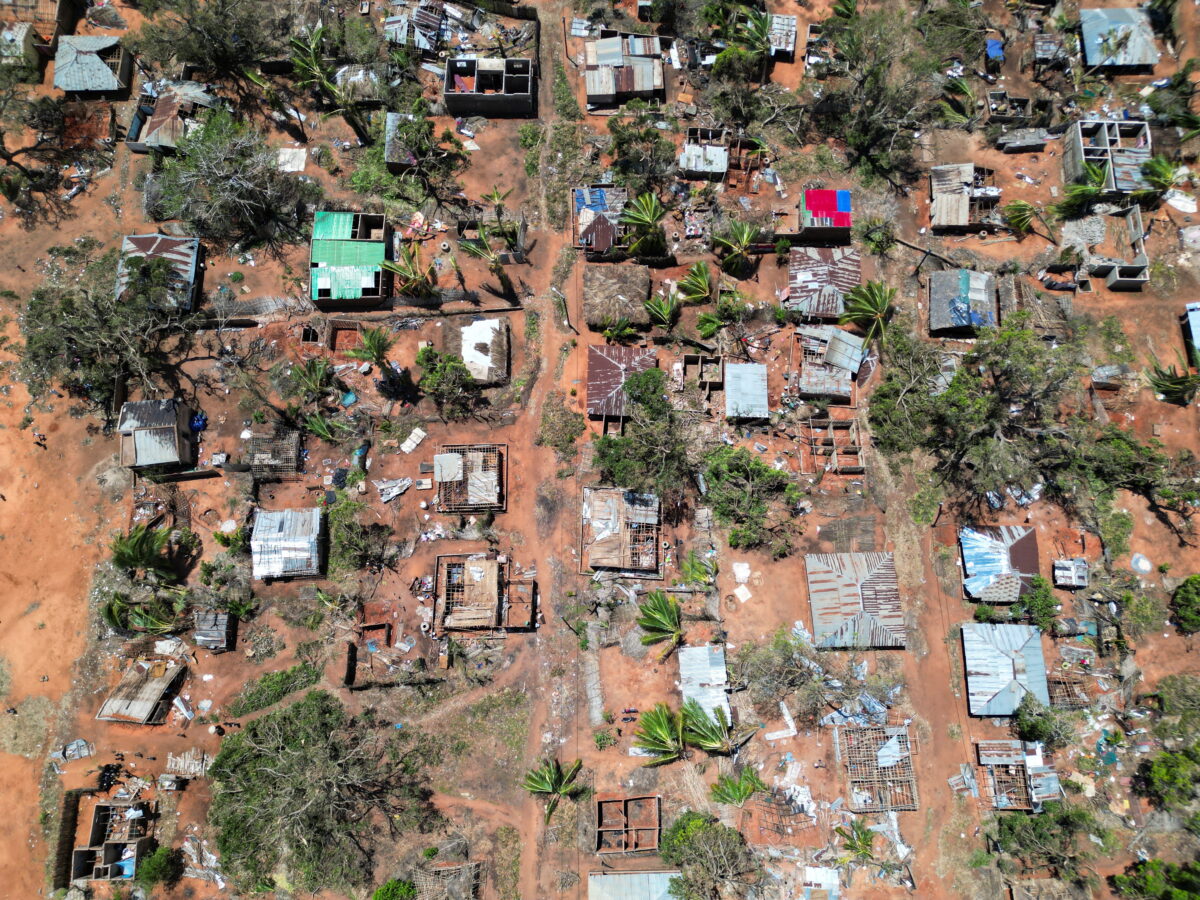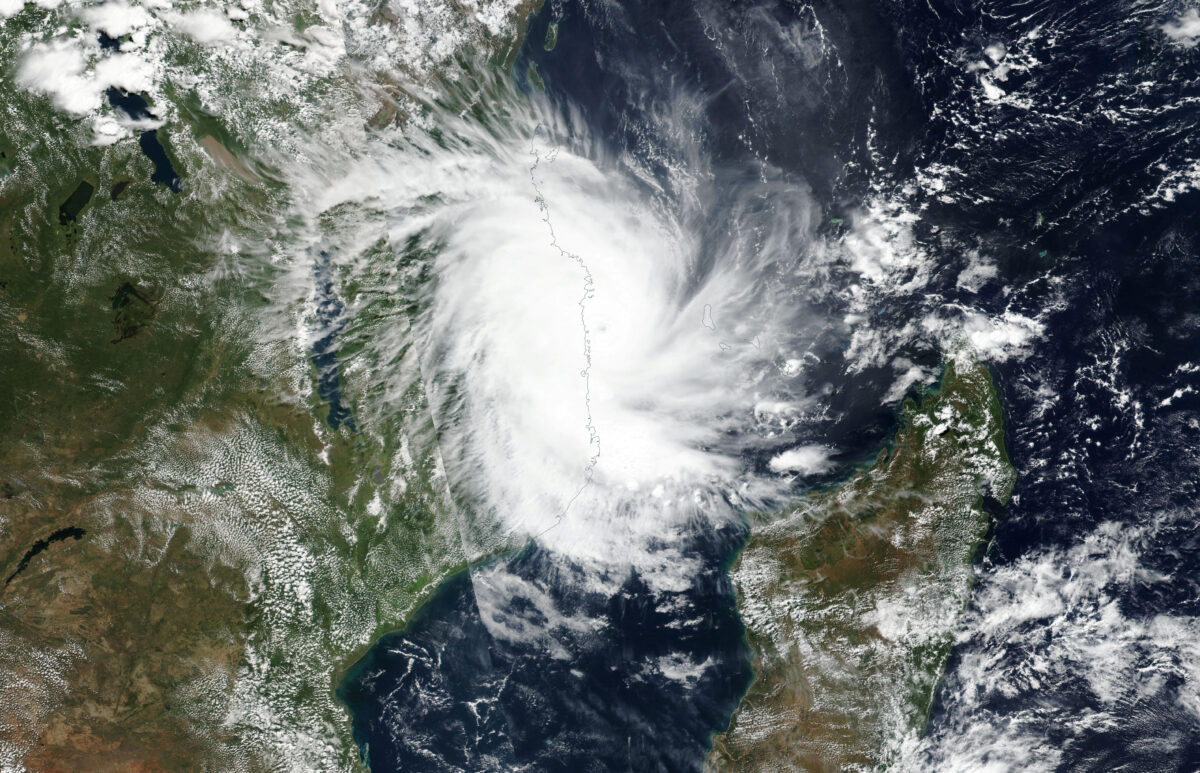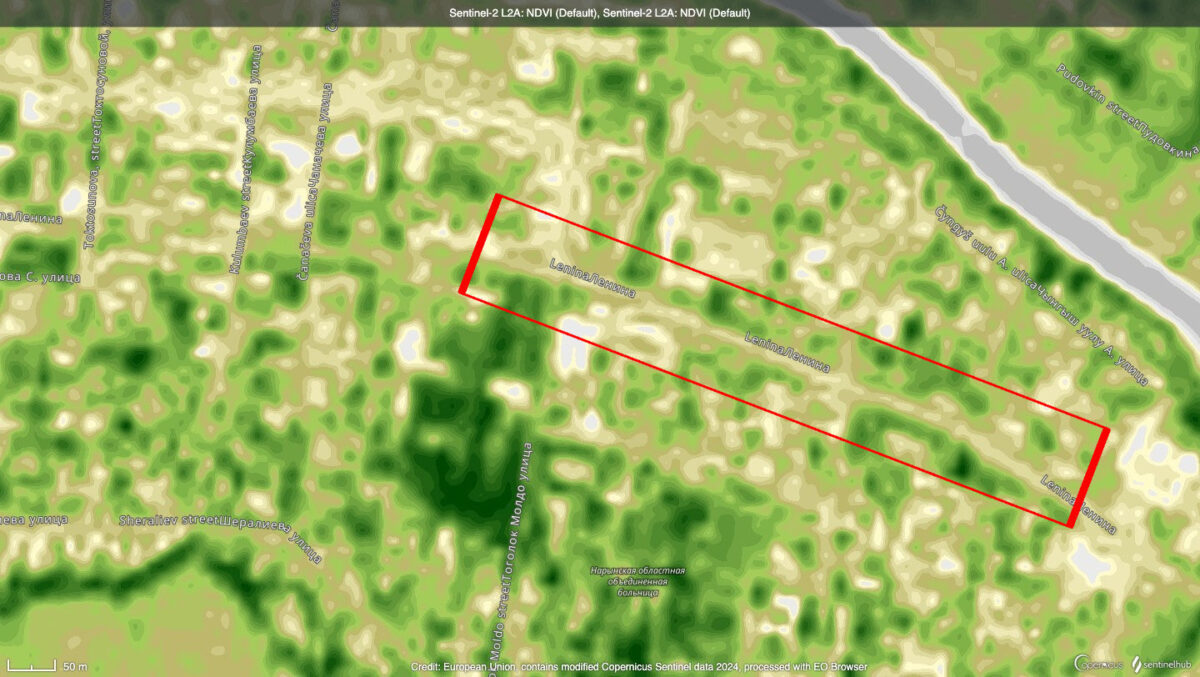No Country for Oil Men: Tracking Islamic State's Oil Assets in Iraq
Introduction
Now the so-called Islamic State (IS) has lost Mosul as their capital in Iraq, two isolated pockets remain where the terror group has control over land, namely Tel Afar and Hawijah. Sustaining their military operations has become more difficult now IS has lost access to their abundant oil resources, both wells and refineries. Reporting suggests the group increasingly relies on oil smuggling to obtain crude and refined oil. Satellite images shows that, just like in Syria, IS is using artisanal oil refining. Our research found over 1600 makeshift structures that have dotted the landscape in northern Iraq, 600 of which in are located Hawijah. This report will provide a short overview of IS main oil operations in Hawijah based on open-source information, using ESA Sentinel 2 and LANDSAT 8 satellites, and high resolution imagery combined with traditional and social media reporting. The conclusions from these open-source research should lead to informed and improved humanitarian responses to specific health risks for civilians working in hazardous conditions and a comprehensive post-conflict environmental assessments of polluted areas.
[Disclaimer: This research is based on prelimenary analysis and needs verification on the ground]
Background
Access to oil was an important goal for IS when they took over Iraqi and Syrian towns and cities in 2014. Within a short period of time, they had vast amount of oil resources [PDF] to under their control, which provided them with enormous financial revenues to fuel their war-efforts. With the crude oil from Deir-az-Zor’s and Palmyra’s oil fields in Syria and Qayyarah’s oil fields in Iraq, IS started to make huge profits from oil extraction and export. Hence the US-lead Operation Inherent Resovlve initiated Operation Tidel Wave II. These operations aimed to disrupt and destroy IS’ abilities to make profits from oil refining by targeting professional and semi-professional oil extraction and refining infrastructure, as well destroying oil tankers to prevent smuggling. To a large extent, this was successful in pushing back IS’ ability to generate income from the oil revenues. But the fight on the ground went slower, with increased fighting over specific oil fields and other unintended consequences. In Iraq, IS controlled various key oil fields and infrastructures that provided support for their oil revenues:
- Baiji: Iraq’s largest oil refinery. Heavy fighting ensued after IS took over in June 2014, with continues attacks by IS after they lost it in December 2014, and retook parts of it in April and May 2015, damaging various parts of it’s infrastructure and setting fire to oil storage tanks. This continues to be the modus operandi, until a huge offensive in October resulted in the defeat of IS at Baiji, where the ISF was supported by the Populair Mobilisation Units (PMUs) and OIR air strikes.
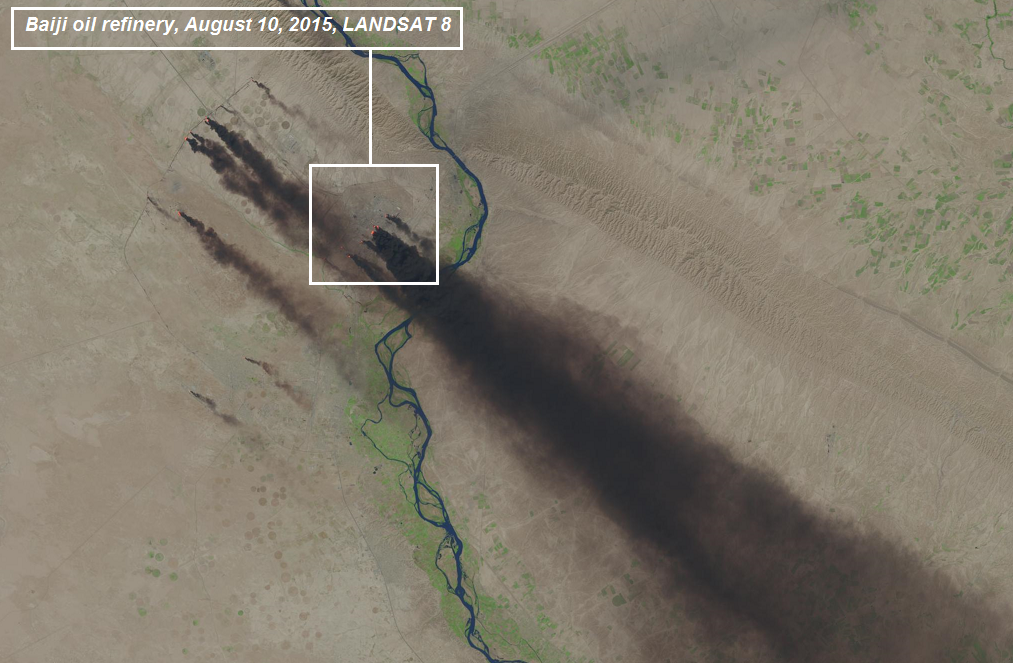
The burning oil refinery of Baiji, image captured by NASA’s LANDSAT 8, August 10, 2015
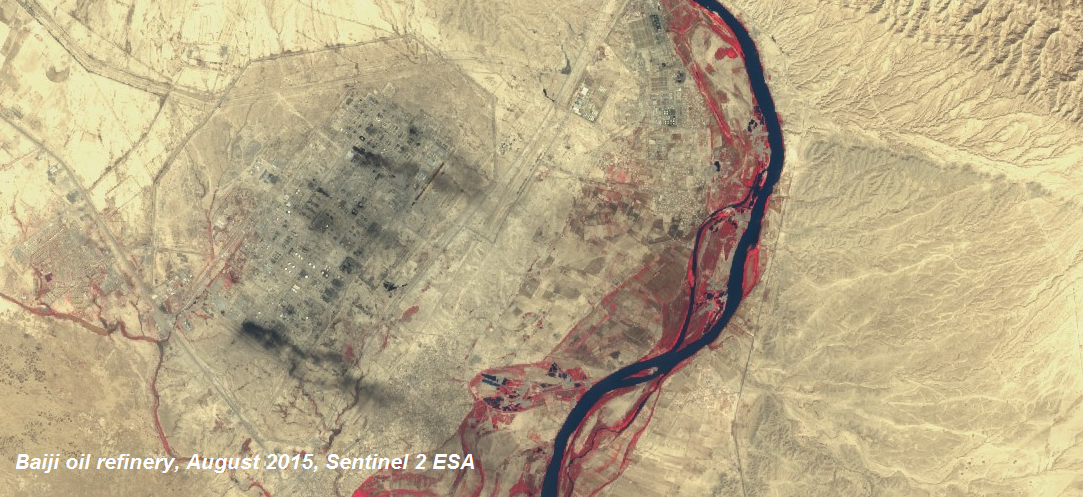
Smoldering oil tankers after most of the fires were put out at Baiji oil refinery, August 21, 2015. Image captured by ESA Sentinel 2, with vegetation index colour band.
- Qayyarah oil fields and refinery:In October 2016, the Peshmerga and Iraqi Security Forces managed to take back control over key oil areas in 2016, namely the 62 wells at Qayyarah severely limiting IS access to oil. But not before IS set fire to 20 oil wells, some of which kept burning for 8 months until March 2017.
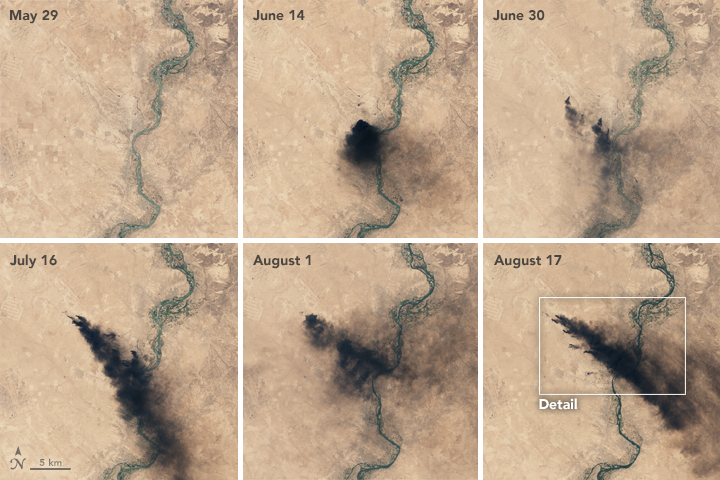
The 20 oil wells that were put on fire at Qayyarah oil field, captured by NASA’s LANDSAT 8 between June and August 2016
- Hamrin oil fields: South of Kirkuk, the PMUs took back control of the Alas and Ajeel oil field. In 2014, it was reported IS started selling crude oil from the Ajeel oil field, that was capable of producing 25.000 barrels per day. In August 2014, OIR strikes against the pumping station limited production, and in March 2015, PMUs largely took back the Ajeel oil field. But while retreating, IS set fire to 9 oil wells. Some of these wells are still burning today, as can be seen on Sentinel 2 imagery.
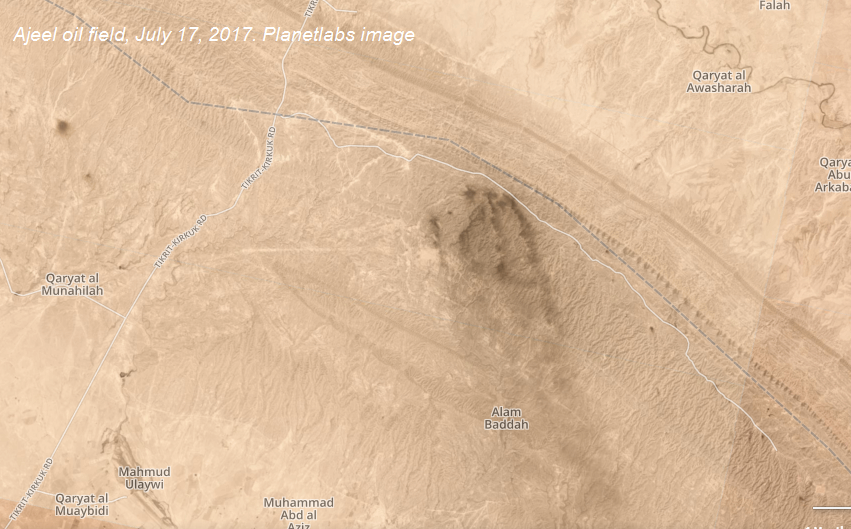
Burning oil wells at Hamrin oil fields, that are on fire since August 2015. Image caputured by Planet Labs satellite, July 17, 2017
Since their loss of major oil incomes, IS shifted to attacks on Kirkuk’s oil wells and installations, sometimes quite successful as demonstrated during the Bai Hassan attack in August 2016, anoil field east of Kirkuk. Other strikes against the Ajeel oil field infrastructures have continued since.
https://twitter.com/iraqi_day/status/795688854334427136
In March 2017, IS attacked the Ajeel oil field, setting four well heads on fire. In July 2017, IS again targeted Ajeel oil field with mortar attacks, and IED type bombs were disabled near pipelines at the Bai Hassan oil field. These examples demonstrate the group’s intent to either destruct and disrupt oil production, and will likely continue the months to come.
Rise of Makeshift Refineries
As Operation Tidel Wave II and Russian Air Force’ airstrikes successfully targeted Syria’s oil infrastructure, IS started to sell crude oil to local civilians and running their own makeshift refineries in Deir-az-Zor province. This operation to take out IS’ oil infrastructure came with some caveats though. An OIR spokesperson acknowledged the complexity that came with targeting economic infrastructure such as oil facilities:
“[…]you have to be concerned about a lot of things. You have to look at what does this do to the population, what does this do from a humanitarian perspective, from an environmental perspective, from a cost of reconstruction — post-conflict reconstruction costs.”
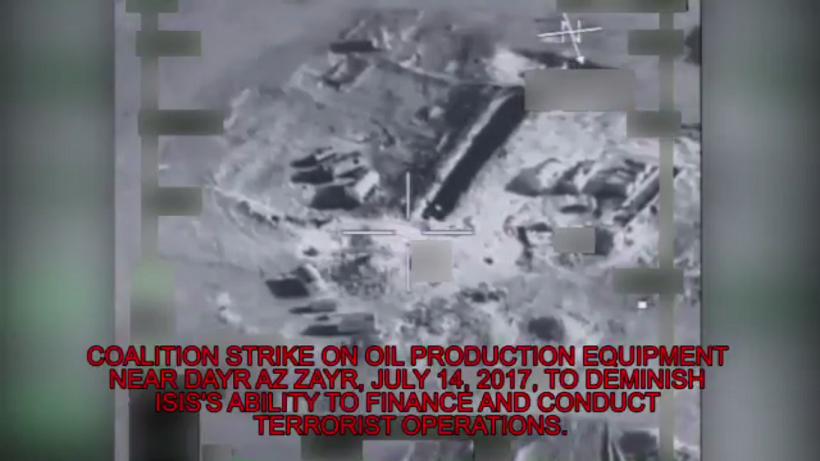
Coalition strike on a makeshift refinery near Deir az Zor, July 14, 2017. Screengrab from CJTFOIR image
Makeshift or artisanal oil refining can indeed come with high costs human health as those operating them are continuously exposed to toxic fumes and hazardous substances that can create acute or chronic health risks. In Syria, a substantial number of children are working at these makeshift refinery sites, in order to generate income for their families by refining and selling oil. While at the same time, severe pollution can create long-term environmental risks to local communities. These artisanal refineries are simple structures that heat up crude oil, and the vapours flows through water trench, condenses and comes out a benzine, diesel or kerosene. See the image below.
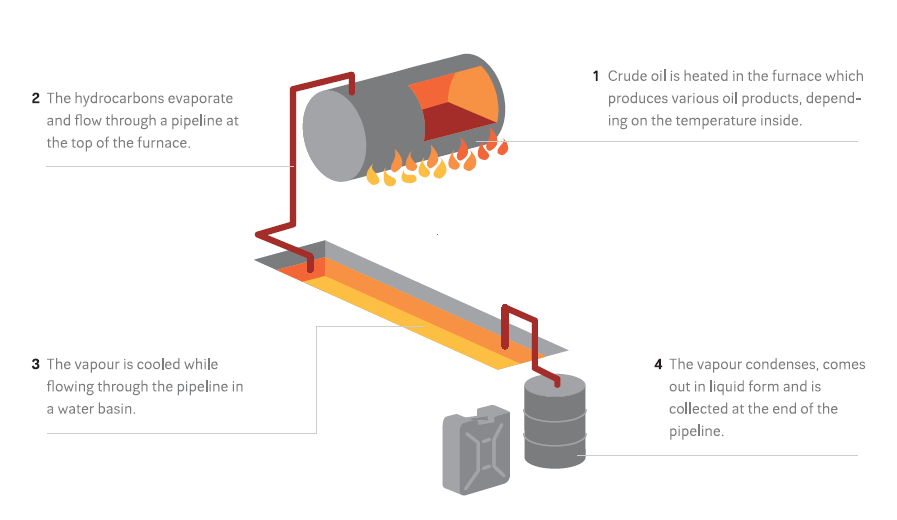
Infographic of a makeshift oil refining structure. Courtesy of PAX
Artisanal oil refining become common practice after Syria descended into chaos late 2012. In September 2016, PAX published their Scorched Earth and Scarred Lives report, an analysis of 5 selected sites out of a total of 37 in Deir az Zor province where artisanal oil refining witnessed a huge increase between 2013-2016. Current estimates are that there likely in the tens-of thousands of these clusters operational throughout the whole of Syria. These sites can now be found throughout not only in Deir-az-Zor, but also Idlib, Aleppo, Hasakah and Raqqa governorates.
oil refineries near Jubb al-Kusa https://t.co/TX7TODVm20 incl. oil distribution https://t.co/gLFBbFbjsM 2/3 pic.twitter.com/Ule1d2kVLV
— Samir (@obretix) July 22, 2017
makeshift crude oil refineries have been set up south of Jarabulus since January 2017. near Tall ash Shair https://t.co/baVpGFo0Pg 1/3 pic.twitter.com/IVBbpe4s3u
— Samir (@obretix) July 22, 2017
Iraq’s Makeshift Industry
As IS also had access to crude oil in Iraq through the Qayyarah and Hamrin oil fields, it started running makeshift refineries near Tel Afar operating 4 major sites, with at least over 525 artisanal refineries. These huge clusters are located on a remote mountain range outside the town of Tel Afar, hence it is likely that those refineries were mainly producing for IS.
Geolocating makeshift #oil refineries in northern #Iraq. Four ISIS oil production sites near Tal-Afar. Likely operated by civilians. pic.twitter.com/AhNHi0mcoa
— Wim Zwijnenburg (@wammezz) January 30, 2017
Another major cluster of refineries can be was found by a reporter of Iraq Oil Report at a site 30 km south of Mosul, reportedly with 600 refineries, but at the moment of discovery the refineries were not used anymore.
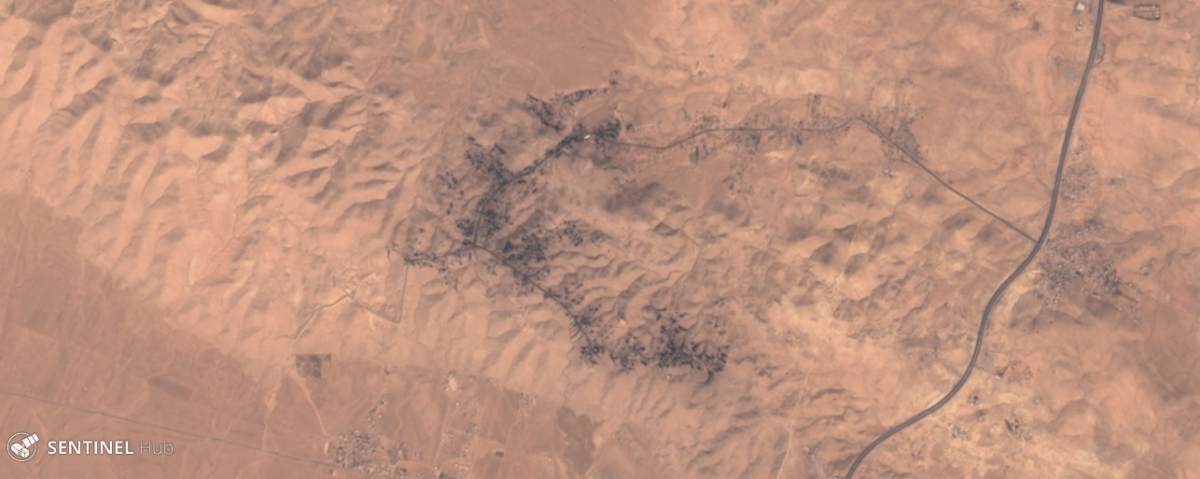
Cluster of makeshift oil refineries south of Mosul. Image by ESA Sentinel 2 on September 14, 2016
Oil was needed to keep the IS’ engines running, so the group had to look for other sources. Estimates are that most of the crude and refined oil likely comes in through smuggling. Yet, it is still possible that IS uses extraction from a few wells in the Ajeel oil field under their control, according to a PMU source, although this is disputed by the Iraqi government and an OIR spokesperson stating that “they no longer control oil fields in Iraq. And the ones that are contested oil areas are not producing”. But recent reporting in August 2017 by Iraq Oil Report indicated that IS still has access to some well in the Hamrin oil field. But with few to no opportunities to refine crude oil, both IS and civilians in Hawijah had to resort to other means.
Analysis
We expected that IS also would use artisanal oil refining in Hawijah, just like in Syria hence a quest started to look for these locations by remote sensing. Using satellite images from Sentinel 2, Landsat 8 and Terraserver, 13 sites were located in Hawijah where artisanal oil refineries in various sizes were operating. For this research, we defined a site as a cluster of makeshift structures, thought at some locations the clusters were separated by only 50 or 100 meters, so the definition is open to discussion. The selected area is the IS pocket of Hawijah, as shown below by LiveUAMap:
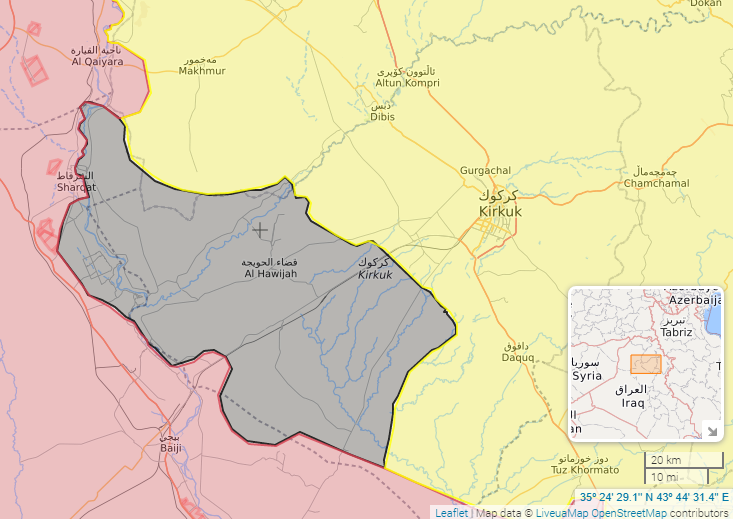
ISIS Live UAMap overview of Hawijah, August 2017
The locations are mostly situated along one main roads east of the Tigris going southwards from Shamilayah towards Al-Zab. These are likely operated as primitive gas stations for civilian traffic, though quite a few seem not to have been in use anymore.
We will start at the sites in the northern part of IS controlled areas, which technically is part of the Kirkuk governorate, south-west of Makhmour. Together the these two clusters are, or have been, operating over 200 artisanal refineries.
More makeshift #oil refiniries between #Qayyarah and #Hawijah, now in #KRG control areas Active under ISIS in 2016 https://t.co/z0r6m6r63C pic.twitter.com/TlvNO0RHju
— Wim Zwijnenburg (@wammezz) August 4, 2017
More southwards, there are smaller sites, some with a couple of dozen refineries, and a bigger one with around 100 refineries halfway on the road towards Hawijah.
Crude #oil refening became common practice near oil wells. Landscape SE of #Qayyarah littered with makeshift sites https://t.co/XfAtGzVrKI pic.twitter.com/17Ff2FmlAI
— Wim Zwijnenburg (@wammezz) August 4, 2017
The next large location can be found along the Little Zab river, north east from where the river ends up in the Tigris, and south-west of the town Shariyah. This cluster has about 50 refineries, including larger modular refining structures.
The last site of interest is hosted at a former Iraqi military base south-east of Hawijah town. Before IS took over, the location was packed with storage facilities and housing areas. Yet recent imagery shows an mostly abandoned place, mainly used for oil refining.
Iraqi army base 46 in Hawija. Fully functioning in 2011, now largely abandoned and used by IS for artisanal #oil refining pic.twitter.com/UFRP6hGWZc
— Wim Zwijnenburg (@wammezz) August 10, 2017
In total, we counted all the structures at these 13 locations identified in Hawijah and they added up to at least 550 artisanal oil refineries, though not all those were operational at the time, but the original structure was still visible.
https://sami-r.carto.com/builder/aedfd8d9-0f43-4724-be9a-dd01601ed73c/embed?state=%7B%22map%22%3A%7B%22ne%22%3A%5B34.827332061981586%2C41.43218994140626%5D%2C%22sw%22%3A%5B36.796089518731506%2C45.0439453125%5D%2C%22center%22%3A%5B35.816795223230116%2C43.23907599999999%5D%2C%22zoom%22%3A9%7D%7D
Some of the larger cluster will like produce enough refined oil for specific goals, for example large amount that can fuel IS’ vehicles, while the smaller sites will use oil refining for civilian purposes such as transportation and household use.
[Update 14-8-2017] Two points to add here: First, a disclaimer should be made as this research is only based on public available satellite imagery. Corraboration with other sources is needed to verify the situation on the ground in terms of who is responsible of running the sites and if they are still in use. Secondly, the assumptions about responsibilities for the oil operations are based on common sense, hence our estimate that the larger sites are operated by IS to fuel their war efforts as they can produce a significant amount of crude. Nonetheless, it is expected that civilians would likely also operate refinieries thus we can not state with fact who is in control of which site.
Operation Inherent Resolve Attacks against IS’ oil facilities.
To understand how OIR perceived the importance these oil operations, we also analysed all the strike reports given by OIR. In total, only 4 reports were given of strikes against oil related targets in Hawijah (or Huwijah, as it is spelled in the US strike reports)
On the July 31, 2017, the OIR strike update mentions an attack against an oil refinement still in Hawijah. This is likely the same location south east of Hawaijah town, as a Sentinel 2 images from the same day shows a huge smoke plume rising from that location.
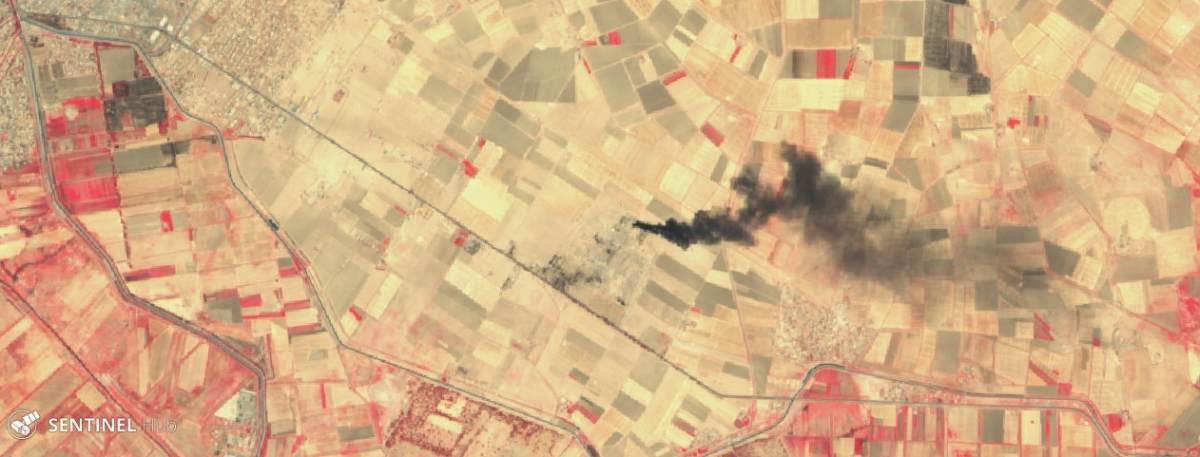
A smokeplume rises from a makeshift cluster at the former Iraq Base 46, south-east of Hawijah town. Image caputred by ESA Sentinel 2, July 31st, 2017
On July 8th 2017 OIR notes an attack on an IS’ fuel point, and on two dates in 2016, namely June 15 and October 16 OIR reported attacks against a modular refinery and an IS oil compound. The locations could not be identified. The small number of strikes against these refineries could be both that these were likely mainly civilian objects, or that the production of oil at these locations was not significant enough for more severe attacks.
We also checked news sources for repots on strikes. The Iraqi news source Basnews reported on the 2nd of June 2017 a Coalition strike in Hawijah near the town Al-Shameet that reported destroyed 12 oil tanks, and a large crude oil warehouse. We looked Planet Labs imagery on those dates near the village Shameet, or spelled Shumayt, but could not see any visible confirmation of such an attack. At that same date, the OIR reported an attack in Hawijah engaging “ISIS tactical units and destroyed an ISIS staging area, a vehicle, and a supply cache.” No indication of targeting oil infrastructure was provided, which raises questions over the accuracy of the news reporting.
Other open-source reporting by the Alghadeer satellite channel on November 2015 indicated that the Iraqi Air Force targeted 40 oil tankers preparing to smuggle oil from Hawija to Syria in the Awashrah area of the town Riyahd, south-east of Hawijah town. Though one could wonder why crude oil should be smuggled to Syria, considering the abundance of oil there. The statement could not be verified with other reporting, either by open sources, OIR strike reports or satellite images from Sentinel 2 or LANDSAT 8 around that date that indicate such a massive attack on crude oil filled tankers.
Conclusion
With the loss of oil fields, professional refineries and increased attacks on oil trucks, IS capacity to extract, refine and export crude has been severly decimated in the last two years. As a consequences of losing professional refineries, a similar pattern with Syria emerged and artisanal oil refineries sprung up in IS controlled areas. It is unclear however if those locations are purely IS facilities or these are civilian operated refineries, and likely civilians should pay IS taxes for the oil sales. Identifying these locations and their activities can be useful in anticipating socio-economic reconstruction plans and indicate a certain dependency of communities on using artisanal oil refining as means income generation. Lastly, the acute and chronic health risks of workers at these sites requires special medial support, just as the potential local environmental impacts due to pollution from waste products in the refining process.
A big thank you to Twitter user @obretix for making the Carto map with the locations and additional geo-locating of makeshift sites in Hawijah.
